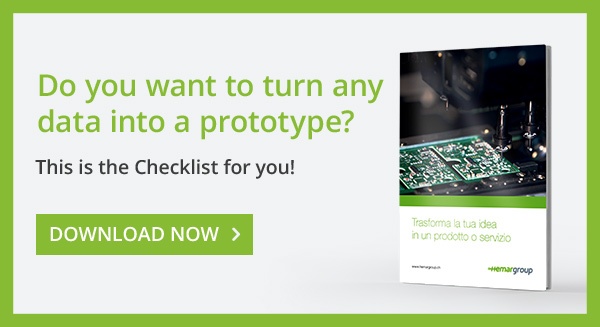
Building an IoT prototype is one of the most satisfying and frustrating engineering experiences in existence. Once the idea process is complete, you’ll face many unknowns along the road to the prototype. Adopting a strategic methodology means making the best use of time and resources, and not banging your head against a wall for months.
Building an IoT prototype requires a strategy!
In many cases, you’ll think it’s ready, switch it on, and then see it fail immediately and spectacularly, catching fire, collapsing or, less dramatically but still frequently, doing absolutely nothing.
What have you forgotten this time?
Prototyping can be very satisfying, but sometimes also frustrating:
- Satisfying because the internet of things presents new opportunities to interact with the world around you, and enable it to interact with you in surprising and exciting ways.
- It's a challenge because while IoT products often appear blindingly simple, they are extremely advanced engineering projects embracing many very disparate disciplines: electrical engineering, firmware development, physical integration, wireless networks, mobile app development, database and server design, and cloud processing.
- It's frustrating because we live in a connected world: the IoT is constantly evolving, and trying to keep up with the latest technology can be very discouraging.
Create your IoT prototype without improvising
Okay, so you've finished the development phase and are ready to make your prototype. Whether your idea is scribbled on the back of an envelope or takes the form of a detailed product design specification, it can often be risky to go straight into building a market-ready product.
There are many unknowns. What are the features that will most interest your customers? Which aspects of your device will they simply not notice? What do they need which is not yet incorporated into your product? And, most importantly, which will be the most expensive and difficult part of the project?
Making wrong assumptions about IoT hardware can be much more expensive than getting your software development wrong, mainly because it takes longer to reconfigure the electronics.
So it’s vital to design a functioning prototype in order to obtain initial feedback, test some of your technical specifications before looking at the aesthetics of the end product and, most importantly, before spending your entire budget on initial full-scale production costs, and then having to change anything because you've got one detail wrong. The solution to this problem is complex, and prototyping is strategically important.
The purpose of this article is to give you the tools you need to carry out your IoT prototyping successfully.
Some of these steps are ones you can take yourself, but if you're to create and develop a new product, it's a good idea to have someone at the helm who knows where to start, what tools to use, and how to design the prototype. This can save you months of development time, and lots of hardware headaches.
Let's break down and understand the requirements of IoT development, to identify the main objectives of prototyping, understand its limitations, and break down the project into its main functional components.
Anatomy of an IoT prototype: an effective methodology
An IoT prototype will always have at least two, and usually three integrated interfaces:
- Physical hardware: silicon, wires, welds, sensors, modules, functions
- Mobile front-end app: this opens on your phone and allows you to read the data from the hardware sensors, activate functions, and interface with your device.
- Web app (back end): this displays cloud-processed information on your device.
Developing an IoT prototype can be difficult because creating the device requires so many different skills: A software engineer may wonder when to design a hardware prototype, or an electrical engineer scratch his or her head about developing an industry-standard mobile IOS to control the device.
The following methodology may be useful in providing a progress chart for your IoT prototype and help you to choose the right tools to build your device.
1: Objectives
What is your prototype for? You're presumably building an IoT prototype because you're working to create something that doesn't yet exist.
What is your device, and what makes it special? What does it do? How does it work? We call this the purpose of the prototype, and it is the key to mapping the flow of information within the device and its levels. Here's how to set objectives for your prototype.
Look at each of its pieces. Look at the physical device. What is its purpose? What is it doing? And how does it communicate with the mobile and/or web app? Look at the mobile app and ask yourself the same questions. Now do the same for the web app.
2: Limitations
Asking yourself the right questions can give you specific answers that tell you the best direction to take. What are the most common limitations of an IoT prototype? Size, cost, battery life, primary and secondary functions to be tested, security etc.
Understanding the key limitations of your prototype will help you to make progress with the project, and most importantly to identify the secondary limitations and the non-problems to be bypassed during the prototyping process.
3: Modules
This is the time to break down your prototype into its functional components, and to identify the most suitable tools and hardware for each one. All IoT products require at least one of the following:
- Communications module: How does the device connect to the internet?
- Power module: Where does it get its power?
- Processor modules: What must the firmware do?
Most IoT products also have some of the following additional modules:
- User input/output: Allow the user to interact physically with the device
- Sensors: Collect and store information about the environment
- Action modules: Allow the device to control and interact with other objects
Conclusion
Prototyping is a fundamental element of IoT product development. However, if you don't first define precise objectives, limitations and modules for your IoT prototype, determining how and where the prototyping process should take place can be difficult and discouraging.
Using the process described in this article to define the IoT prototype paths clarifies its objectives and can serve as a guide in selecting the right tools to carry out a quick, satisfactory and obstacle-free prototyping process.
Once you've identified all the functional modules of the device, finding the right hardware from online suppliers will become a much quicker and error-free process, and you can finally begin construction of the IoT prototype!
.png)
